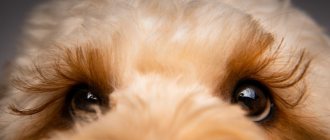Every dog breeder sooner or later faces the problem of purulent discharge from the eyes of a dog. A thick green, yellow or gray liquid that forms in the corners of the eyes causes discomfort to the animal. Failure to provide first aid, lack of proper care and late seeking veterinary help can negatively affect the health of your pet.
Norm or pathology
Vomiting, diarrhea, lack of appetite - everything is clear here. You need a consultation immediately. And if a dog’s eye is red and festering, is it a disease or should I just wait a little? Most often, owners prefer the second option. In fact, there can be many reasons for this. The hair has curled up, encountered an unexpected obstacle - then the redness and lacrimation will go away within a few days. But there are more serious reasons that cannot be dealt with without a veterinarian.
How can you wash your dog's eyes at home?
Regular eye hygiene products can be used as needed. It is not recommended to use drugs with therapeutic effects independently without diagnosis and consultation with a doctor.
Important requirements for the rinsing solutions used:
- Before use, hold the liquid in your palm for some time to warm it up.
- Follow the rules of asepsis.
- Follow all recommendations of the veterinarian-ophthalmologist for performing procedures (sequence, frequency, intervals between manipulations, etc.).
Pharmacy products
- 0.9% sodium chloride solution. The most affordable means for carrying out the procedure. Saline solution is used for copious rinsing and removal of contaminants.
- Furacilin. To obtain a concentration that can be used for the procedure, you need to dissolve 1 tablet (20 mg) in 100 ml of sterile distilled water. The solution is used to wash the eyes of a dog with inflammation of various etiologies.
- You can wash your dog's eyes with a solution of Chlorhexidine, diluting it to a concentration of 0.01%. To do this, take 4 ml of the drug and add 16 ml of sterile saline solution.
- Miramistin can be used to wash your pet's eyes in the original concentration. It is used for dogs as part of complex therapy for various pathologies.
Expert opinion
Kuzmenko Olga Olegovna
Information about the expert
Ask a Question
Be sure to follow the instructions for storing the drug: temperature, presence of light, permissible duration of use after opening the bottle. Expired drops should never be used.
Special cleaning products
- Diamond eyes. Drops are used for preventive and therapeutic purposes for conjunctivitis and various infections of the organ of vision.
- Espree lotion is a veterinary hygiene product.
- Ophto-Lavas solution is intended for hygienic purposes and has a soothing effect.
- Oftal (from Beaphar) is suitable for daily treatment and rinsing.
Folk remedies
- A decoction of chamomile flowers. To avoid getting plant particles into the prepared solution, it is better to buy the drug in special tea bags. 1 filter bag is immersed in hot water (200 ml) and left to infuse for 15 minutes. Cool the prepared broth before use. You can rinse with chamomile for various pathologies, as well as for the purpose of daily hygienic cleaning.
- Tea brewing is the most popular folk remedy that can be used to wash out a festering eye, as well as remove normal mucous discharge. Treatment with tea is carried out several hours after it is brewed.
Careful inspection
You should not immediately draw any conclusions. If a dog's eye is red and purulent, the first thing you need to do is pay attention to the condition and behavior of the pet. After this, evaluate the nature of the discharge itself. They can be mucous or purulent, which in itself says a lot. During the examination, the veterinarian will not devote the owner to the details of his observations; he often does not have time for this. But a loving owner himself should know the physiological characteristics of his pet and the symptoms of diseases.
So:
- Mucous discharge is oxidized tears. If there are few of them, you can consider this condition normal and not worry. The color of the eyes does not change, the animal feels great and eats well.
- A large amount of discharge, even if it is clear and does not contain pus, is a symptom of irritation. The cause may be dust getting into the eye, inflammation of the eyelids, or conjunctivitis. In general, it is difficult to make an accurate diagnosis without an examination by a veterinarian. These diseases are not too serious and can be easily cured, especially if you deal with this issue in time.
- If a dog's eye is red and festering, this most often indicates a more serious lesion. Pay attention to the color of the discharge. If they are yellowish or greenish, this indicates inflammatory diseases of the eyelids. This also includes a number of other ailments, for example, purulent discharge is characteristic of plague.
Making a diagnosis yourself is strictly not recommended. A specialist must assess your pet’s condition and prescribe treatment. Moreover, you cannot start treating your dog yourself using antibiotics. During the consultation, you will need to remember all the details, when you first noticed the presence of discharge, what happened during these days (new food was given, new furniture was bought, repairs began). Do not forget to draw the doctor’s attention to minimal changes in the animal’s behavior. Does your pet refuse food, does he actively run during walks?
Professional treatment
In a veterinary clinic, before starting therapy, the doctor will definitely find out the cause of the disease. This may require taking blood tests, calculating the leukemia formula, and additional studies are possible in each individual case.
Owners often ask whether it is possible to drip Albucid into the dog’s eyes. Human medications are not recommended to be given without consulting a veterinarian. An ophthalmologist, indeed, can in some cases prescribe this drug, but only after examining the patient. After all, if used incorrectly, albucid can cause irritation of the mucous membrane and cause a chemical burn. Your veterinarian may also prescribe special veterinary drops. They contain recommended dosages of medications and are safe to use.
If the visit to the veterinarian was late, purulent inflammation can provoke the appearance of a cataract. Cloudiness of the cornea is accompanied by the appearance of a white spot on the dog’s eye. In this case, an appointment with an ophthalmologist is required. And to establish a final diagnosis, an ultrasound of the eye, examination of the fundus, and measurement of intraocular pressure may be required. If a complication is confirmed —
the necessary therapy is prescribed. You cannot delay this, because untimely treatment can result in loss of vision for your pet.
Eye infections
There are a huge number of them: fungal, bacterial, viral (blepharitis, endophalmitis, uveitis, bacterial conjunctivitis, viral keratitis) and a number of others. Almost always, in the presence of a general infectious disease, the animal experiences an elevated temperature. At the same time, the pet refuses food and may experience severe vomiting or diarrhea. Difficulty breathing also indicates the development of an infection.
If the disease affects only the organs of vision, then, in addition to purulent discharge, the dog experiences swelling. Often the animal begins to blink and wince because it is in pain. If your dog's eyes are red and purulent, then you need to take immediate action. And you need to start with a visit to the clinic.
Symptoms of eye inflammation in dogs
The first alarming signs of inflammation begin to appear when the owner detects copious mucous secretions. Every day, lumps of mucus appear in the corner of the eye. The fur around the eyes becomes moist, and there is a feeling that the dog’s eyes are constantly wet. If wet paths are not wiped off, crusts will form. Over time, the crusts become more and more numerous, the infection multiplies more and more intensely, and the pet’s condition worsens.
Quite severe itching appears, the dog scratches its eyes, actively helping itself with its paws, and rubs its head on the furniture. Often this behavior further irritates and injures the mucous membrane. The affected eyelids swell, the eyes turn into narrow slits. The dog begins to see worse. If the owner notices the whites of the dog's eyes are red, conjunctivitis has definitely set in. Immediate treatment is required.
Without treatment, the situation will get worse. The mixture of bacteria and mucus causes pus to form. Purulent contents accumulate between the eyelids, causing blockage of the tear ducts. The pet keeps his eyes closed more and more often. Under the influence of pus, ulcerative lesions may develop. The dog's general condition worsens: the animal refuses to eat, hides from bright light, body temperature rises, and weakness appears.
Whatever the underlying cause of the eye damage, if the animal tries to rub its face with its paw or scratches itself on surrounding objects, it is necessary to use a protective collar —
this will help avoid further negative effects on the delicate structures of the organ, eliminate infection from the external environment and trauma
Allergic reaction
This is one of the most common reasons for this problem. If the whites of your dog's eyes are red and purulent, then you need to think about whether you are feeding him correctly. Today, many people switch their pets to dry food. But this is not always the best option for your pet. Consult your veterinarian. He will tell you which brand to choose and what to avoid. Stores usually sell cheap food by weight, which has very low protein content and no meat. This is compensated by dyes and flavors. Needless to say, such a product is a strong allergen.
Unfortunately, identifying the cause is not always easy. The reaction can be cumulative. For example, several months ago you switched your pet to a new food, which is positioned as high-quality, super-premium class. And suddenly you notice discharge from your eyes. You need to immediately go to the doctor and tell about all the events that have taken place recently.
It is important to know what the animal reacts to. This could be household chemicals, hair care products, dust or flea bites, administered medications and vitamins. In addition, the animal will have severe itching of the eyes and ears, as well as the entire body. Sometimes there is a deterioration in the condition of the coat and skin, flaking and itching appears. In this case, it is important to find the source of the allergy and also use antihistamines.
How can you accurately determine the cause of the pathology?
The exact cause of red eyes can only be determined after a comprehensive examination at a veterinary institution. The doctor will examine the pet and conduct tests that are necessary in a particular situation (blood, cytology).
If there is pus discharge from the eyes, a viral infection is a possible cause. In this case, swabs are taken. The received materials are sent to the laboratory for further research using PCR and ELISA methods.
Lack of vitamins
This is also directly related to nutrition. Purulent lacrimation may be caused by a lack of vitamin A. It is found in offal, vegetables, herbs and eggs. Most often, animals that do not have the opportunity to eat properly and variedly suffer from hypovitaminosis. This should also include those who eat plenty, but their diet is limited by low-quality economy-class food, poor in vitamins and microelements. In this case, the only thing that needs to be done is to diversify the diet with meat, fish, grains and vegetables. Gradually the condition will return to normal.
Associated symptoms
If there is a small amount of clear discharge, you don’t have to worry about your pet’s health. The reason for their appearance is accumulated tear fluid. The presence of pathology is indicated only when the color of the discharge changes to yellow-green, grayish or red.
In addition to the color change, you should pay attention to other accompanying symptoms. Depending on the cause, abnormalities can occur not only in the eyes, but also in other organs.
Tumor of the eyelids
Due to constant itching, the animal scratches its eyelids with its paws or by rubbing against surrounding objects. Scratching causes irritation and injury, accompanied by swelling of the eyelids.
Redness
If the proteins are clean, then one or more hemorrhages, characteristic of mechanical damage, can be seen in them. If the irritation is too strong, the entire protein turns red. Redness is accompanied by a burning sensation and profuse lacrimation.
Itching
Untreated wet areas dry out on their own and form crusts. They are accompanied by itching and pain, so the animal constantly tries to relieve the discomfort with the help of its paws.
Deviations not related to the eyes
Deterioration of the condition can be noticed by behavioral changes. A sick pet loses its usual activity, does not follow commands well, avoids communication and refuses its favorite treats. Also, the presence of the disease can be indicated by the appearance of vomiting, fever, unpleasant odor from the ears, bloating, diarrhea or constipation.
Response to Trauma
If the dog lives in an apartment and walks under the supervision of the owner, then there is not much chance that he will not know about the event that occurred. It’s another matter if the animal goes outside on its own. If the next day after the dog returns one eye is red and festering, it can be assumed that it was damaged during a skirmish with tailed rivals or cats. If an animal has damaged its eye, the discharge will be clear at first, and only after infection has attached does pus appear.
It can be even simpler. The dog was injured after running into a branch. Or a small pebble bounced off and hit your eye. In this case, exactly the same thing happens as in people after a blow. The dog's eye is red and festering, he is worried or tries to spend more time in his house.
In case of eye injuries, it is indicative that problems are observed only on one side. The dog squints the injured eye or closes it completely. The second one is clean. Treatment in this case is symptomatic. It is necessary to examine the eye to ensure that there are no foreign objects left in it. After this, treat with chamomile or calendula infusion and observe. If the condition does not improve within two days, contact your veterinarian.
When can this be done at home?
Treatments can be carried out at home in the following cases:
- The general condition of the pet has not changed: the dog is active, willingly walks and plays, appetite and thirst are preserved.
- Body temperature is within normal limits (37.5-39.0°).
- The animal does not experience discomfort in the area of the organ of vision (it does not rub its paws or on foreign objects, it calmly allows its eyes to be examined).
- The color of the conjunctiva is light pink, moist.
- The discharge rarely accumulates and is brown or light gray in color.
- In older animals, over the years, the cornea becomes cloudy, less tear fluid is released, but mucopurulent discharge accumulates. Such pets need to be washed regularly to avoid pus and further complications.
Some dog breeds require additional hygiene throughout their lives:
- Brachycephalic (boxer, pug, bulldog).
- Animals with drooping eyelids (basset hound, mastiff, spaniel, cane corso).
- Breeds with bulging eyes (Pekingese, Chihuahua, Japanese Chin).
- Pets with bangs (Scottish Terrier, Giant Schnauzer, Yorkshire Terrier, West Highland White Terrier).
Irritation of the mucous membranes of the eyes
We continue to consider possible reasons. Are your dog's eyes red and puffy? Maybe she has recently had the opportunity to come into contact with caustic substances such as bleach, turpentine, alcohol? If the animal has access to the garage, then this is quite possible. It should be added here that one-time inhalation of vapors leads to lacrimation. But if the dog is forced to inhale fumes of caustic substances regularly, the discharge may become purulent. In this case, it is necessary to exclude contact, after which improvement will follow. In addition, the doctor may recommend washing the eyes with light antiseptics and herbal decoctions.
Irritations and chronic diseases
Often the reasons why redness and purulence of the eyes are observed lie in their irritation as a result of contact with caustic volatile substances, detergents, and household chemicals. Particularly sensitive animals with delicate skin on the eyelids and corneas begin to cry a lot. The appearance of pus is observed with constant contact with the irritant. The development of conjunctivitis is promoted by exposure to:
- dust;
- smoke;
- sand;
- long wool.
Some dogs already suffer from chronic diseases at birth, these include corneal and eyelid defects. An example would be a drooping eyelid. As a result, a large amount of dirt accumulates in this place over time. In this case, the pet is guaranteed to have chronic conjunctivitis, so it is necessary to constantly subject the eye to hygienic procedures.
Breed Features
We are talking about animals with long hair that falls into the eyes. This could be a poodle, lapdog, Komondor and others. Simply ignoring regular haircuts can lead to the development of similar symptoms. Are your dog's eyes red and puffy? This means you need to examine them carefully. If the hair hangs freely from the forehead, then the hairs will act as a constant irritant to the mucous membranes. You can wash them and bury them as much as you like, but until you solve this issue, there will be no lasting improvement. If it is not possible to do a haircut, then you need to adapt a soft headband that will keep the hair raised.
Algorithm for the procedure
- Prepare all the necessary tools in advance (cotton pads, a syringe without a needle, rinsing solutions should be at a comfortable temperature).
- Hands are washed thoroughly and, if necessary, disposable medical gloves are worn.
- The pet is called to you and seated (representatives of small breeds can be placed on the table).
- Use your left hand to fix the animal's muzzle so that it does not twitch. With the other hand, wipe the eye with cotton wool soaked in the prepared solution. The movement is carried out from the outer corner to the inner (towards the nose).
- If it was not possible to remove all the dirt at one time, repeat the steps using a new piece of cotton wool.
- If there are purulent crusts on the eyelashes and eyelids, they should first be softened by applying a cotton pad for a few seconds, or by dropping a hygiene product directly onto the problem area.
- The second eye is treated in the same way.
- If it is necessary to wash a wound on the eye, the animal’s eyelids are carefully closed with two fingers and sanitation is carried out. For this procedure, you can use a solution of Chlorhexidine or Miramistin.
After the procedure is completed, the pet is praised and rewarded with a treat or play.
Weakening of the immune system
Just like humans, our little brothers have many diseases. This refers to ailments not only of the visual organs, but also of the heart, lungs and liver. Any of them provokes a weakening of the immune system, which also contributes to the penetration and development of eye infections. Therefore, it is so important to first diagnose and only then begin treatment.
The dog's eyes are red and fester very often in old age. This is due to a natural decrease in immunity. Therefore, in animals over 10 years of age, this problem is considered a normal variant. The doctor can select chloramphenicol, tetracycline or other drops that will help maintain eye hygiene.
Prevention
To avoid dangerous ophthalmological diseases, suppuration and early clouding of the cornea, simple preventive measures should be followed. Useful tips:
- systematically cleanse the eyes of pus, rinse with chamomile, sterile water or saline;
- when bathing, avoid getting shampoo on the mucous membrane, which can cause irritation of the mucous membrane;
- monitor the length of the hair in the head area, thin out the eyebrows in a timely manner;
- treat chronic diseases, adjust the daily diet taking into account taste preferences, age and physical activity.
Some breeds are recommended to undergo surgery to change the length and area of the eyelids during childhood (Shar Pei, Basset Hound). Blepharoplasty improves your pet's appearance and helps avoid serious problems in the future.
How to help and what to do
The dog’s eyes are red and purulent, which means you need to make an appointment with a veterinarian. This is not even discussed, since there are many reasons for this condition. The problem is serious; without proper treatment, complications can develop that lead to loss of vision. After diagnosis, the doctor will tell you what can be done.
What if a visit is not possible right now? Do you live in a rural area and it’s a long drive to the nearest clinic, or is your appointment scheduled for the next day? In this case, you can try to provide first aid to relieve pain in the animal.
What to do in case of emergency
If you notice that the dog is acting restless and scratching its head, and the cornea is inflamed and there is a large amount of pus, then urgent measures need to be taken. Carefully examine the eyes and, if necessary, carefully remove the foreign body. Moisten a cotton pad with saline solution and gently wipe each eye. Contact your veterinarian as soon as possible to determine the cause of the disease and prescribe treatment. Throughout the entire period of therapy, monitor your pet’s behavior and undergo regular scheduled examinations. Report any complications or the appearance of atypical features.
Memo to the owner
- The first step is to clear the eye of any discharge. This will allow for an examination and will also bring some relief to the pet’s condition. You need to remove the pus with a clean bandage; cotton wool is worse in this regard, as it can stick to the sore eye. The bandage needs to be moistened, for which a decoction of chamomile, calendula or other anti-inflammatory herbs is suitable. In fact, this is where first aid ends. But when a veterinarian is unavailable, what should you do? The dog’s eye is red and purulent, which means there is an inflammatory process. To level it out, it is necessary to use antibiotics.
- The selection at the pharmacy is quite extensive. Most often, pharmacists offer Albucid. But this drug causes a strong burning sensation, so it is better to look for an alternative. Levomycetin helps great when the eyes are red and festering. Eye drops do not cause discomfort to dogs; they can be instilled up to 6 times a day. And of course, before each procedure you need to remove pus from the eyes.
- Ciprovet drops are good for relieving inflammation. They are instilled 1-2 into each eye, four times a day.
- You can wash your eyes with furatsilin solution. To do this, you need to dissolve one tablet in a glass of warm water. You can combine this treatment with anti-inflammatory drops.
- Tetracycline ointment helps a lot. It should be applied under the animal’s drawn eyelid. After this, close your eye and massage it well.
How to apply eye drops or ointment to a dog?
Eye drops or ointments are prescribed by a doctor for medicinal purposes. Before using such drugs, the dog's eyes must be washed.
- To administer eye drops, you need to use two fingers to separate your dog's eyelids and use a sterile pipette to drop the required amount of medication into the upper outer corner of the eye. Next, you can make a couple of blinking movements with your fingers, closing and opening your eyelids so that the drops are distributed evenly.
- To apply eye ointment, use your thumb to slightly pull down your dog's lower eyelid and use the sterile tube spout to squeeze the required amount of ointment directly onto the mucous membrane. And just as when applying drops, make several blinking movements with your eyelids.
If the doctor has prescribed several drugs, then before each use of different drops it is necessary to maintain an interval of at least 15-20 minutes.
Unobvious causes of redness
Let's look at the reasons that are not directly related to pathologies, but are caused by diseases of other parts of the body, or the whole organism, but as a consequence lead to redness of the whites of the eyes.
Allergy. A large proportion of dogs suffer from an allergic reaction, which is caused by any environmental factor. Allergies can be caused by inappropriate foods, chemicals, fleas, toys that contain materials that the dog's body does not accept, and much more. The eyes will be red and watery.
Injuries. Red eyes, watery eyes, fever, lethargy and other symptoms may be caused by injury. The animal can injure both the eye and other parts of its body. These could be impacts, collisions, fights with other animals, cuts from foreign bodies and other reasons.
Parasites. There may be a parasitic life form inside a dog's body, such as helminths. The disease caused by helminths is called “Helminthiasis”. A dog can become infected with eggs, larvae and mature forms of helminths anywhere and anytime, for example, from the feces of other dogs in whose feces they are present, or by eating poorly thermally processed food.
Infectious diseases. May cause symptoms of eye redness and watery eyes, accompanied by suppuration and lethargy.
Autoimmune diseases. When they occur, the eye becomes red, tears and pus appear, and the dog becomes lethargic.
Tumors. When neoplasms or tumors (malignant or benign) form in the animal’s body. The eye may become red and lethargic.











